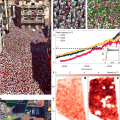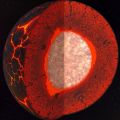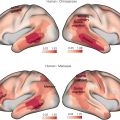Système des ganglions de la base du primate - Définition
La liste des auteurs de cet article est disponible ici.
Sous systèmes et modèles
Les représentations systémiques utilisent de manière ordinaire le »schéma boîte-flêche« où les éléments sont des boites et les connexions de simples flèches. Les »boîtes« sont supposées être clairement distinctes des autres, closes et homogènes. Les flèches n'ont pas de poids en nombre d'axones, ni de combinatoire. Dans des modèles récents, le cortex est réduit à une boîte (comme si cela était possible) et le thalamus »moteur« à une autre boîte mèlant induement le thalamus cérébelleux d'une part et le »thalamus des ganglions de la base« , pourtant soigneusement séparé en thalamus pallidal et thalamus nigral. Le ( »VA-VL« complex) n'a aucun fondement mais une grande puissance dévastatrice pour comprendre le système.
Several models have been proposed at about the same time. Anatomical works have demonstrated that there is a strong compression of numbers of neurons meaning a numerical convergence (Yelnik et al.1984 and Percheron et al. 1984). This objective »funneling« has been attacked in the opposed model of Alexander et al.(1986), Alexander and Crutcher (1990), presented under several other forms. These authors priviledged distinct chains of anatomical connexions that would escape funneling to preserve 5 to 6 »basal ganglia-thalamocortical circuits«: motor, oculomotor, prefrontal (dorsolateral prefrontal and lateral orbitofrontal) and limbic (or anterior cingulate), which through the basal ganglia and the thalamus would return to the initial point of the cortex. This »parallelist« view did not fit with the observable anatomy. As repeatedly proven, the corticostriate connexion does not follow the Kemp and Powell topography (1970). In addition to compression there is an intrication of subsystems (e.g.the oculomotor component intricated with the frontal one). The thalamo-cortical connexion does not follow simple rules and usually have several cortical targets. Another model, and probably the most famous (Albin et al.1989)(later admitted to have been too simplistic) selected two criteria: the inhibitory/excitatory character of connexions and the mediator involved. Current models place the role of the subthalamic nucleus in a privileged position due to the fact that it is excitatory when the striatum, the pallidum and the nigra have inhibitory mediators. To a »direct pathway« (cortex-striatum-medialpallidonigro-thalamo-cortical)(5-circuit) was opposed an »indirect pathway«(cortex-striatum-lateral pallidum-subthalamic nucleus-medialpallidonigral-thalamo-cortical) (6-circuit). Connexions were links without defined numbers of axons and no topological varieties. The particularly complex system of the basal ganglia yet incites to more refined systemic analyses, with systems (defined very simply as elements in interactions) and subsystems with same properties. The opposition between output subsystems and regulator subsystems does not correspond exactly with that made between the core and the regulators. One part of the core, the lateral palliduum, is indeed a part of the core and a regulator. It does not send axons to the thalamus and from there to the cortex. All its efferent axons instead are returning inside the basal ganglia system. With its main target the subthalamic nucleus they constitutes together a particular subsystem, with two high frequency autonomous pacemakers, one inhibitory (GABA) and one excitatory (glutamate). The subthalamic nucleus sends axons to another regulator: the pedunculo-pontine complex (also excitatory, glutamatergic). This and the central complex are elements of other basal ganglia regulating subsystems.
In addition to the nigrotectal connexion (too often minimised), there are two output subsystems starting from the striatum, each forming 3-path to the cortex. They do not send axons (then no regulatory messages) either to the striatum, lateral pallidum or subthalamic nucleus. The first output path from the striatum has its first relay in the medial pallidum (GABAegic, inhibitory). This sends axons (again GABAergic and inhibitory) to a particular place of the thalamus, the nucleus ventralis oralis VO (see 'human thalamus) . VO sends its axons to the accessory motor and to the motor cortex (with glutamate as the mediator). The second output subsystem follows exactly the same pattern, but, this time, starts from the nigra reticulata. Nigral axon go to the nucleus ventralis anterior VA. This VA not exactly corresponding to the fuzzy usual nucleus sends axons to the frontal cortex and the oculomotor areas (glutamatergic). Striato-pallidonigral and pallidonigral-thalamic connexions are inhibitory. The separation of the two subsystems corresponds to a differentiated cortical distribution. There is not one »direct« but two output circuits in primates: one is cortex-striatum-medial pallidum- VO-SMa and the other is cortex-striatum-nigra reticulata-VA- anterior cortex. There are many arguments against treating in the same manner the »indirect circuit« involving a regulator circuit and the output circuits. The new data concerning morphology and physiology raises problems. The fact that the pallidonigral set (as defined above) is a high-frequency pacemaker (1) emitting inhibitory signals (2) receiving at low frequency, but in possibly large numbers, messages from the striatum that are also inhibitory should modify the way of reasoning. Adaquate striatal patterns might carve, by desinhibition, an appropriate pattern of signals (a message) to the thalamus and from there to the cortex. Some axons from the lateral pallidum go to the striatum (Sato et al.2000). Above all, many of them go to other basal ganglia elements: the medial pallidum, the nigra reticulata and the subthalamic nucleus. The activity of the medial pallidum is thus influenced by afferences from the lateral pallidum and from the subthalamic nucleus (Smith, Y., Wichmann,T.,DeLong, M.R. 1994). The same holds true for the nigra reticulata (Smith, Y., Hazrati, L-N, Parent, A. 1990).
Concerning the ordinary model,there is not one »direct« but two output circuits in primates: one is cortex-striatum-medial pallidum- VO-SMa in one hand and the other is cortex-striatum-nigra reticulata-VA- anterior cortex in the other. There are many arguments against treating in the same manner the »indirect circuit" involving a regulator circuit and the output circuits. Among other ways of looking to the basal ganglia system, that indicated by morphology and physiology raises problems. The pallidonigral set (as defined above) is a high-frequency pacemaker (1) emitting inhibitory signals (2) receiving at low frequency but in possibly large numbers of messages from the striatum that are also inhibitory. Adaquate striatal patterns thus might carve, by desinhibition, an appropriate pattern of signals (a message) to the thalamus and from there to the cortex.

















































